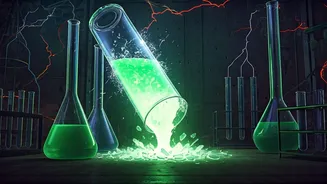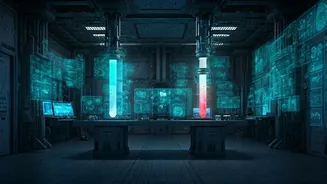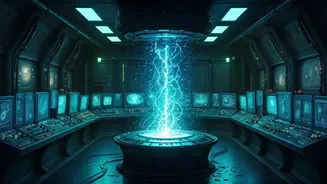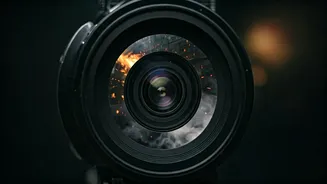Gravitational Shenanigans Exposed
One of the most common science slip-ups in movies involves gravity. Think of scenes where explosions occur in outer space with loud, dramatic sound effects.
In reality, space is a vacuum, and sound waves require a medium to travel; therefore, there would be no sound. Another example can be observed where planets explode in a Hollywood movie. Often the visual depiction has the planet shatter in pieces. But planets lack the structural integrity to be shattered. They are held together by gravity. These cinematic embellishments highlight the tension between scientific accuracy and the pursuit of visual spectacle for entertainment purposes. These kinds of mistakes happen because the goal is not to educate, but to deliver an action-packed, thrilling experience, even if it requires bending the laws of physics. However, these are glaring errors that make scientific accuracy a secondary consideration in the process of filmmaking.
Sound in Outer Space?
Hollywood's depictions of space often fall prey to a fundamental scientific error: the propagation of sound. A vacuum is a space devoid of matter; in outer space, there's no medium, like air, for sound waves to travel. Nevertheless, many movies depict space battles with explosions and the roaring of spacecraft. The absence of sound in space does not create a cinematic experience that offers audiences that same level of thrills and excitement. The impact of a missile or the explosion of a spaceship is far less exciting if there is no accompanying sound. The film industry prioritizes the viewers' experiences of excitement, therefore making dramatic sounds in space a common occurrence despite it being scientifically impossible. This is a deliberate choice made to amplify the drama and engagement of the viewer, enhancing the visual spectacle rather than adhering to scientific accuracy.
Dinosaurs and Humans Together?
The time travel trope, while a staple in science fiction, often leads to major scientific inaccuracies, especially when dealing with prehistoric eras. Consider films that depict dinosaurs and humans coexisting. The reality is that non-avian dinosaurs died out approximately 66 million years ago, far before the emergence of humans. Such scenarios typically disregard the vast geological timescale and the evolutionary processes that separate these two species. This scientific inaccuracy is often a byproduct of narrative expediency and the desire to create a spectacle. Such inaccuracies enable the filmmakers to develop more exciting stories, providing audiences with entertaining experiences. The focus remains on delivering an engaging narrative even at the expense of scientific credibility.
Instant Space Travel & Speed
Another frequent misrepresentation involves the speed of light and interstellar travel. Many movies portray instantaneous travel between stars or planets, bypassing the constraints of the speed of light. This is not how the universe works. In the real universe, even with advanced technology, traveling from one star system to another requires significant amounts of time due to the immense distances involved. These cinematic choices are made to make the story more convenient, for instance, in terms of action or to accelerate the plot progression. These distortions are often viewed as necessary to maintain audience engagement. As in many science fiction plots, the need to compress these voyages into manageable screen time often trumps the accuracy of the science. This allows for a more accessible and fast-paced storyline, even if it deviates from established scientific principles.
Hollywood’s Explosions
Explosions in movies are another area where filmmakers routinely take liberties with scientific accuracy. Often, the size and force of explosions are exaggerated for visual impact, defying the laws of physics. The way fire behaves, the intensity of the flames, and the resulting debris are also often inaccurately depicted. Hollywood frequently employs dramatic explosions, such as fireballs expanding rapidly without regard for factors like available oxygen or the surrounding environment. Such exaggerations are a critical element in action sequences. These visually stimulating scenes are designed to elicit a strong emotional response from the audience, often prioritizing spectacle over scientific authenticity. The dramatic visual is prioritized, often at the expense of scientific accuracy. These cinematic exaggerations are key ingredients to create dramatic scenes that will captivate the audience and enhance the overall cinematic experience.
Technology and its Limits
The portrayal of advanced technology is another frequent source of scientific inaccuracies. From hacking scenarios to the use of futuristic weapons, movies often bend or ignore the current limitations of real-world technology. Artificial intelligence (AI), in particular, is frequently oversimplified, where characters achieve feats that are beyond the AI capabilities. Similarly, in many films, computers can hack into complex systems within seconds, disregarding the protection measures and time constraints. These dramatic shortcuts serve the narrative, and they help create high-stakes tension and propel the plot forward. While these depictions can enhance storytelling, they often stray far from the actual capacities of present-day or near-future technologies. This helps to create more impactful and exciting stories.
Evolutionary Missteps
Movies can make incorrect portrayals of evolutionary processes. The speed at which evolution happens is often incorrectly portrayed. The speed of evolutionary change is frequently accelerated, as filmmakers compress millions of years of biological transformation into a few seconds of screen time. The natural selection processes are simplified, and the complexities of adaptation and genetic mutation are often ignored. These cinematic inaccuracies stem from the need to create fast-paced narratives. The need to show the results of evolution for entertainment value can lead to significant oversimplifications of evolutionary processes. These simplifications, while necessary for cinematic storytelling, often create a distorted representation of the scientific concept of evolution. This is done to improve the appeal of the movie and enhance the excitement and tension.











